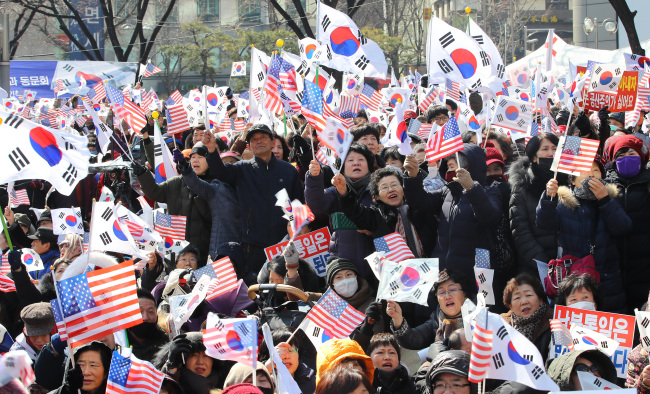Rallies, ceremonies held around Seoul to mark March 1 Movement
By Bak Se-hwanPublished : March 1, 2018 - 16:04
Tens of thousands of conservative civic groups gathered near Seoul’s Gwanghwamun Square on Thursday afternoon and marched during a rally to mark the 99th anniversary of the March 1 Independence Movement of 1919.
While they commemorated the 1919 movement that declared independence against the Japanese colonizers, anti-government rallies, dubbed “Taegeukgi rallies,” mostly chanted calls for a strong South Korea-US alliance, a pre-emptive strike against North Korea and the immediate release of impeached and detained conservative President Park Geun-hye, who is under trial for corruption allegations.
While they commemorated the 1919 movement that declared independence against the Japanese colonizers, anti-government rallies, dubbed “Taegeukgi rallies,” mostly chanted calls for a strong South Korea-US alliance, a pre-emptive strike against North Korea and the immediate release of impeached and detained conservative President Park Geun-hye, who is under trial for corruption allegations.

Separately, ceremonies commemorating the March 1 Movement and rallies against Japan also took place around the country.
A memorial ceremony was held in Gwanghwamun to remember the victims of forced labor during Japanese imperial rule. A day earlier, the remains of 33 Korean forced laborers were returned to Korea from Japan to be buried Friday at Seoul City Yongmi-ri Second Cemetery Park.
The remains of another 35 victims will return home next year as part of a civic group’s efforts to bring them home in line with victims’ requests to be buried in their motherland after death.
So far, a total of 101 bodies have been found and identified as forced labor victims, including the remains of 35 bodies to be brought back to Korea, according to Seoul Metropolitan City.
Meanwhile, Local religious groups staged a protest in front of the memorial “comfort women” statue installed just outside the Japanese Embassy in Seoul to honor wartime sexual slavery victims. The protest came after Japanese Chief Cabinet Secretary Yoshihide Suga described President Moon Jae-in’s televised comments as “extremely regrettable” on Thursday. Earlier in the day, Moon called the wartime sexual slavery a “crime against humanity” and said that the matter remains unresolved.
To remember the public’s resistance to Japanese military occupation and honor those who died fighting for the country’s independence, the annual bell-ringing ceremony started at noon at Bosingak in Jongno. It was attended by Seoul Mayor Park Won-soon and descendants of independence fighters.
Just before the ceremony, a Seoul-sponsored marathon took place in southeastern Seoul, which was joined by Park and Olympic marathon silver medalist Lee Bong-ju for the race, while actors and performance groups chanted “Daehan doknip manse” or “Hurray, Korean Independence” marching and waving national flags near Bosingak as part of the celebrations to mark the day.
Anguk Station on Line 3 near Bukchon and Insa-dong, where key independence activities were carried out, has been renovated to showcase a special exhibition in line with the 99th anniversary events. The exhibition displays the country’s independence movement, forced labor victims during World War II who were drafted to Hokkaido in Japan, and the lives of independence activists, including Kim Koo and Ryu Gwan-sun.
Independence Movement Day, also called Samiljeol in Korean, was acknowledged as a national holiday in 1949. In 1919 in Seoul, a total of 2 million people, most of whom were students, staged a peace protest and declared independence. During the peace protest, 7,509 were killed, 50,000 arrested and 16,000 injured by the Japanese military.
By Bak Se-hwan (sh@heraldcorp.com)








![[KH Explains] Hyundai's full hybrid edge to pay off amid slow transition to pure EVs](http://res.heraldm.com/phpwas/restmb_idxmake.php?idx=644&simg=/content/image/2024/04/18/20240418050645_0.jpg&u=20240419100350)






![[From the Scene] Monks, Buddhists hail return of remains of Buddhas](http://res.heraldm.com/phpwas/restmb_idxmake.php?idx=652&simg=/content/image/2024/04/19/20240419050617_0.jpg&u=20240419175937)

![[KH Explains] Hyundai's full hybrid edge to pay off amid slow transition to pure EVs](http://res.heraldm.com/phpwas/restmb_idxmake.php?idx=652&simg=/content/image/2024/04/18/20240418050645_0.jpg&u=20240419100350)

![[Today’s K-pop] Illit drops debut single remix](http://res.heraldm.com/phpwas/restmb_idxmake.php?idx=642&simg=/content/image/2024/04/19/20240419050612_0.jpg&u=)